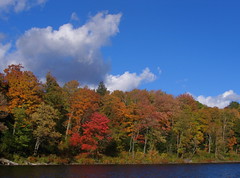 These days we are bombarded with countless reports of climate models predicting every side of the coin. Warmer waters will both increase and decrease the chance of hurricanes making landfall in the US, according to whatever model you want to base your opinion on. But these are all smooth projections, and do not allow for anthropogenic forcing.
These days we are bombarded with countless reports of climate models predicting every side of the coin. Warmer waters will both increase and decrease the chance of hurricanes making landfall in the US, according to whatever model you want to base your opinion on. But these are all smooth projections, and do not allow for anthropogenic forcing.
Already I’m loving this article, because it deals with a word with five syllables, and there’s another one to come.
Simply put, and thanks to my Oxford Dictionary Thesaurus, ‘anthropogenic’ simply means “originating in human activity.” Wikipedia takes it further, thanks to an unlimited size, and describes ‘Anthropogenic effects, processes, objects, or materials are those that are derived from human activities, as opposed to those occurring in natural environments without human influences.’
So when we discuss anthropogenic forcing in terms of the climate, it is a simple step to explain it as the human created problems that force themselves upon the climate with unexpected and often irreversible results.
This is essentially what a new report published in the “Proceedings of the National Academy of Sciences” (PNAS) and written by a team of international scientists has to say.
The opening line of the Potsdam press release says that ‘Anthropogenic forcing could push the Earth’s climate system past critical thresholds, so that important components may “tip” into qualitatively different modes of operation.’ This is essentially telling us that our climate could be pushed in to ‘different modes of operation’ that differ substantially in quality to what we expect, or predict.
“Society may be lulled into a false sense of security by smooth projections of global change,” the researchers around Timothy Lenton from the British University of East Anglia in Norwich and Hans Joachim Schellnhuber from the Potsdam Institute for Climate Impact Research report. However in some regions of the world there are some climate systems that could be dramatically and quickly affected by anthropogenic forcing which could subsequently tip the said system over the edge. The researchers term these sub-systems of the Earth system as a “tipping element.”
The researchers drew on a workshop of 36 leading climate scientists in October 2005 at the British Embassy in Berlin, Germany, as well as a further 52 elicitations from 52 experts in the field, and a review of the pertinent literature. From these sources they created a list of nine potential tipping elements. Together, they rank as the most policy relevant that also require consideration in international climate politics.
The authors sorted the nine elements in to three categories; highly sensitive tipping elements with the smallest uncertainty; intermediately sensitive tipping elements with the largest uncertainty; and Lowly sensitive tipping elements with an intermediate level of uncertainty.
From the top category, those with the highest level of sensitivity and with the smallest uncertainty include the Arctic sea-ice and Greenland ice-sheet. The Greenland ice-sheet’s tipping point for disintegration is unknown, due to an inability to observe dynamic deglaciation accurately, but in a worst case scenario the researchers posit it could disappear within 300 years, raising the worldwide water levels up by to seven meters. As for the Arctic sea-ice, it is pretty much what we have heard time and time again; less ice means less reflectivity which means warmer waters which means increased melting which …
With a larger uncertainty but a lower sensitivity are locations such as the West Antarctic ice-sheet, the Amazon rainforest and Boreal forests, the El Niño phenomenon, and the West African monsoon. We have heard less about these, but research studied shows that the West Antarctic ice-sheet is losing mass. They predict a worst case scenario similar to that of the Greenland ice-sheet. The Amazonian and Boreal forests are seen to suffer under a continued warming, and with the Amazons already manic deforestation, a lessening of rain could only increase this problem.
Lastly, the Atlantic thermohaline circulation registers in with a lower sensitivity but with an intermediate level of uncertainty. The circulation of sea currents in the Atlantic Ocean helps to generate a lot of the Northern Hemisphere’s climate. Driven by seawaters that flow to the North Atlantic, cool and sink at high latitudes, a large influx of freshwater could seriously disrupt this mechanism.
Such a melting is occurring from the Greenland ice-sheet and the Arctic sea-ice, and if warming continues it could see the element past the tipping point, seeing the North Atlantic current disrupted, sea levels rising and a shift in the tropical rain belt occurring.
There is more information at the link below, so make sure to check it out for the full story. This is truly a fascinating report, and one that will undoubtedly generate some talk.
Photo Courtesy of 416style via Flickr
AN EXCELLENT WAKEUP CALL !!!!